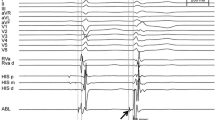Summary
Management of patients with ventricular tachycardia (VT) is often difficult. Drug therapy is often ineffective. Implantable cardioverter defibrillators (ICDs) can terminate VT episodes but do not prevent them. Radiofrequency (RF) catheter ablation can suppress arrhythmias in selected patients. However, the procedure is often challenging and success rates lower than for ablation of supraventricular tachycardias. The mapping and ablation approach depends on the VT mechanism. Monomorphic VT in patients without structural heart disease is referred to as idiopathic and has a focal origin. These VTs can be abolished by ablation in most of the patients. In VT due to reentry within an area of scar from an old myocardial infarction or cardiomyopathic process, critical parts of the circuit may be difficult to localize, rendering RF ablation challenging. In patients with monomorphic VT, prevention of VT recurrence can be achieved in 55% to 80% of patients. Multiple morphologies of VTs and circuits that are located deep in the endocardium are common problems that reduce efficacy. Furthermore, mapping to identify target regions for ablation can be more difficult if VT is rapid and not tolerated, or not inducible. Recently, multisite mapping of the arrhythmia substrate during sinus rhythm or multisite activation mapping of a few VT beats were shown to be effective for ablation of these “unmappable VTs”. Bundle branch reentry tachycardia occur in patients with nonischemic cardiomyopathies, mostly valvular heart disease and can be successfully abolished with RF ablation of the right bundle. However, some of these patients may develop recurrences due to other types of VT. Recent technical developments have increased efficacy and simplified the approach of RF ablation of VT in patients with structural heart disease. However, long-term efficacy is not accurately predictable and implantation of an ICD is mandatory in most of the patients with severely depressed left ventricular function.
Zusammenfassung
Die Behandlung von Patienten mit ventrikulären Tachykardien (VT) ist häufig problematisch, da Antiarrhythmika oft nicht ausreichend wirksam sind und implantierbare Cardioverter-Defibrillatoren (ICDs) die Ereignisse zwar meist terminieren, jedoch nicht deren Auftreten verhindern. Radiofrequenz (RF)-Katheterablationen bieten die Möglichkeit, Rhythmusstörungen bei einigen Patientengruppen zu kontrollieren, jedoch sind diese Interventionen oft komplex und die Erfolgsrate ist geringer als bei supraventrikulären Tachykardien. Die jeweilige Mapping- und Ablationsstrategie hängt von dem spezifischen Mechanismus der VT ab. Monomorphe VTs bei Patienten ohne kardiale Grunderkrankung werden als idiopathisch bezeichnet, haben einen fokalen Ursprung und können in den meisten Fällen erfolgreich abladiert werden. VTs, die auf einem Reentry-Mechanismus im Bereich einer alten Infarktnarbe oder einem Kardiomyopathie-Fibroseprozess beruhen, sind oft schwierig zu lokalisieren und somit zu abladieren. Bei Patienten mit monomorpher VT werden durch eine Katheterablation in 55–80% rezidivierende VTs verhindert. Multiple VT-Morphologien und Reentry Circuits, die sich tief endokardial befinden, sind häufige Probleme, die die Effizienz der Methode einschränken. Weiterhin ist bei Patienten mit sehr schnellen, hämodynamisch nicht tolerierten oder nicht induzierbaren VTs ein Mapping problematisch. Eine Ablation dieser „nicht-mappbaren” VTs ist dennoch möglich durch Strategien, die Ablationslinien- oder areale anfertigen, basierend auf im Sinusrhythmus analysierten Eigenschaften des Narbengebiets oder mit Techniken, die erlauben, mit nur einigen Schlägen einer VT deren Aktivierungssequenz zu untersuchen. Patienten mit dilatativer, vor allem valvulärer Kardiomyopathie haben eine erhöhte Inzidenz von Bundle-Branch Reentry Tachykardien, die mit RF-Ablation des rechten Tawara-Schenkels erfolgreich therapiert werden können, jedoch treten bei diesen Patienten häufig auch VTs eines anderen Mechanismus auf. Durch die Entwicklungen der letzten Jahre ist die Katheterablation von VTs bei zugrundeliegender kardialer Erkrankung einem breiteren Patientenspektrum zugänglich geworden, wobei die Erfolgsraten gleichzeitig gestiegen sind. Jedoch ist ein Langzeiterfolg noch nicht genau vorhersehbar und eine ICD Implantation muss bei den meisten Patienten mit deutlich eingeschränkter linksventrikulärer Funktion empfohlen werden.
Similar content being viewed by others
Author information
Authors and Affiliations
Additional information
Eingegangen: 10. Juli 2001 Akzeptiert: 28. September 2001
Rights and permissions
About this article
Cite this article
Brunckhorst, C., Delacrétaz, E., Duru, F. et al. Radiofrequenz-Katheterablation ventrikulärer Tachykardien. Z Kardiol 91, 2–15 (2002). https://doi.org/10.1007/s392-002-8366-z
Issue Date:
DOI: https://doi.org/10.1007/s392-002-8366-z




